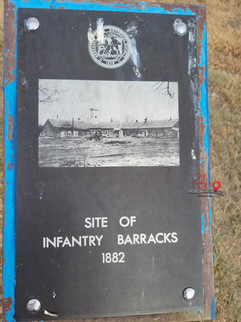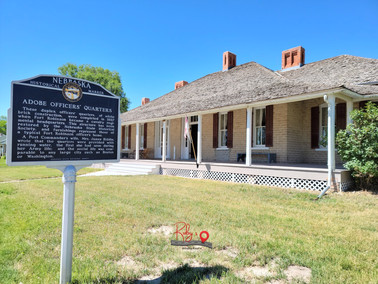Fort Robinson State Park was on our list of places to stop and visit this past summer and we did just that. The Fort is located just west of Crawford on U.S. Route 20 in northwest Nebraska. Entering the 22,000-acre park we were struck with the unusual feeling of arriving at a vacation resort surrounded by a deep and serious history lesson.
After checking in at the park office, we found our campsite and set out to explore the park. Honestly, there was a lot to see. During the summer season, visitors can take part in Jeep tours, ride horses, go hiking, ride in a stagecoach, fish, play tennis (or pickleball for us), or splash about in the pool. There are also a couple of museums on site including the Fort Robinson History Center and the Trailside Museum of Natural History which currently features a mammoth fossil display. But the main museum is the park itself. With its historic buildings and historical markers, it's easy for visitors to become immersed in the past just walking the grounds. Anyone who enjoys digging into lessons about the early days of the Plains region will remain occupied during a visit to this destination.
Fort Robinson's past is long, varied and the topic of history books. We'll just provide a very brief overview of its significance. Fort Robinson began as a temporary encampment in 1874 and was renamed Fort Robinson in 1878. Through the years the Fort continued to expand until it became one of the largest military installations in the northern Plains. Its initial role was guarding the Red Cloud Agency. Fort Robinson played an important role in the Sioux Wars in the late 1800s. It was also at this location that Chief Crazy Horse, War Chief of the Oglala Sioux, resisted imprisonment and was killed. Markers memorializing Chief Crazy Horse are installed here.
Upon the construction of the railroad, Fort Robinson expanded its regional importance as the U.S. Army was able to transport large numbers of troops and supplies through the Plains region. In the early 1900s Fort Robinson became one of the largest centers for training and breeding horses and mules for the U.S. Army. The U.S. Olympic Equestrian teams trained here between 1935 and 1939. The Fort was also used to train large numbers of military dogs for the K-9 Corps in the early 1940s. During World War II, Fort Robinson housed prisoners of war.
Nearing the middle of the twentieth century in 1947, the U.S. Army abandoned Fort Robinson and the site began to serve as a beef research operation for the USDA. Eventually, the property was transferred to the State of Nebraska for public use and was established as a state park in 1962. The park acquired additional neighboring land in the early 1970s increasing its size to more than 22,000 acres.
While some of the buildings at Fort Robinson have been reconstructed, several original buildings from its days as a fort are still in use today. We walked through many of them and also paused at the marker for Chief Crazy Horse. A marker is also in place for Lt. Levi H. Robinson, for whom the Fort was named after he was killed by Native Americans while on a wood gathering detail near Fort Laramie.
Fort Robinson State Park is a unique opportunity to step back into time and learn about how our country developed. Bring your walking shoes and some bug spray. We spent time walking through the grassy areas to read informational displays describing where buildings had once been located as we gained an understanding for the magnitude of the Fort. As we walked, the winds of the plains whispered the tales of a vast and powerful area history.
If you're wishing to visit, plan to stick around for a few days as there is plenty to see and do. You'll learn a lot if you take the time. You can also relax for a bit in the beauty of the northern Plains. We rested on the massive front porch of the 1909 Brick Barracks while gazing at the buttes and sipping a cold soda after a very long walk. The building is the only remaining structure of fifteen enlisted men's barracks and housed members of the 8th and 12th Calvary.
The park has many ways for guests to stay the night. Park officials offer a campground for tent camping, as well as full or partial hookup sites for RVs. Guests can also rent cabins or stay in the lodge. Though we made our own meals in our RV, there is a restaurant available at Fort Robinson which serves breakfast, lunch and dinner during the summer months. Ice cream, sodas and other treats can be purchased in a snack shop. There is a small gift shop with a minimal number of T-shirts, post cards and other tourist trinkets in the main office. Gift shops are also in the on-site museums.
The park grounds are open through the year, but many of the on-site attractions are only available during the summer season. You can learn more about Fort Robinson State Park and its schedule of attractions by visiting Nebraska Game and Parks at outdoornebraska.gov.
Thanks for reading our blog. Don't forget to tap the "like" button on this post and subscribe for free to Ruby's Winding Road at the bottom of this page so you don't miss a post. Visit the Gallery at RubysWindingRoad.com to view pictures of other places we've visited. We post new photos regularly. In the meantime, we'll be out wandering.

















Comments